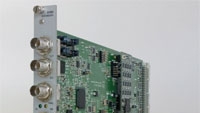Stagetec's 3G audio embedder/de-embedder

Walk into any TV production or broadcast facility today, and you're guaranteed to run across embedded audio. Whether for transmission, routing or archiving, it's pretty much the norm to embed audio within the video signal. The main reasons for embedding audio, besides a reduction in cabling, are:
- Vastly simplified cabling as the video and up to 16 channels of audio travel on one coax.
- The need for audio and video to always be in sync, especially in the digital domain.
- The fact that separate audio and video routers are not needed when the program is ready for transmission.
But that solves only the transport and storage of completed programming. To work with the audio during the production process, the audio channels need to be separated from the video. Enter the embedding/de-embedding process.
Stagetec's NEXUS digital audio router system has a distributed modular structure, intuitive controls and reliability. It offers a full contingent of audio and communication interfaces and is typically found in master control rooms, broadcast facilities, OB trucks and live performance centers.
The XHDI-02 card is the second-generation HDI interface for the router system. It is an audio embedder/de-embedder card for video signals compliant with SMPTE 259M (SD), SMPTE 292M (HD) and SMPTE 424M/425M (3G). There are a total of 16 I/O audio channels at 24 bits conforming to SMPTE 272M-AC (SD) or SMPTE 299M (HD/3G) standards.
The primary functions of the card are:
- De-embeddingAny audio signal can be extracted from the video stream and be routed on the audio network.
- EmbeddingAny audio signals on the audio router system can be embedded into the video stream. The groups and channels to be written are freely selectable. Audio data from other blocks originally contained in the video stream are retained. Channels from the same group can be reapplied.
- ReplacingWith regards to the numerous data structures possible in the SMPTE specifications, the card allows new audio to be written to existing data structures. This will embed only the pure audio data. This mode provides a high degree of compatibility even for nonstandard streams, for example, if only two audio channels are defined for a group.
- DeletionAudio groups already contained in the video signal or marked for deletion are entirely deleted or overwritten.
De-embedded audio is available for routing across the whole router network. It can be routed channel by channel to any combination of audio outputs (MADI, AES, analog, TDIF, etc.) and to any other XHDI card for embedding. De-embedded audio from an XHDI can be routed to an XDSP audio processing card for EQ, filtering, mixing, etc., and then returned to the card for re-embedding.
The card accepts synchronous and asynchronous HD/3G video signals. Sample rate converters (SRCs) on the card will match the audio router system's clock if different. The card also has a special function in HD/3G mode in that it time-aligns the audio blocks in embedding/de-embedding modes. For greater flexibility, the card is available in BNC or fiber-optic (LC, single-mode) versions.
The professional video industry's #1 source for news, trends and product and tech information. Sign up below.
The card offers video pass through with a video delay of zero to 15 frames for SD and zero to eight frames for HD/3G if needed. There is onboard DSP that is available for processing (gain, noise-shaping) on all audio channels.
There's a direct link from the card to the Dolby E Encoder (XDEE) and Decoder (XDED) cards within the audio router system to embed and de-embed asynchronous audio and nonaudio signals. The card has been tested by Dolby Labs and has received its certification.
A two-channel metadata embedder/de-embedder is compliant with SMPTE 2020-1 and 2020-2 standards. The metadata signals are routable through the network. There is an adjustable audio delay of 0ms to 170ms at 48kHz for the transmission channel.
The NEXUS system is extremely reliable and flexible because of its distributed architecture. The XHDI-02 card is a complement to the full array of interfaces available to the digital router system. It has already been installed in multiple facilities around the world, including ESPN headquarters in Bristol, CT.
Rusty Waite is president of North American operation at Salzbrenner Stagetec Mediagroup.
